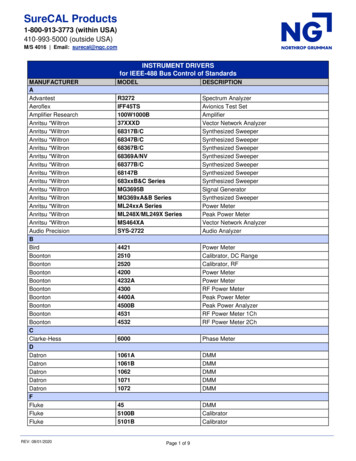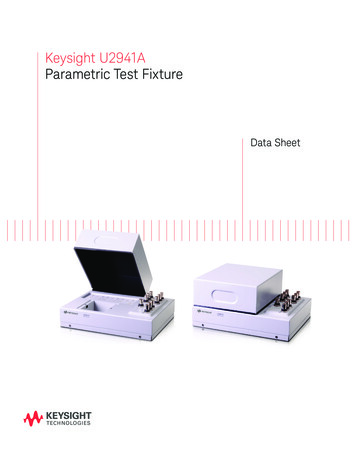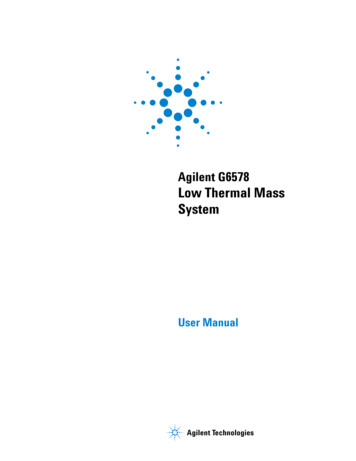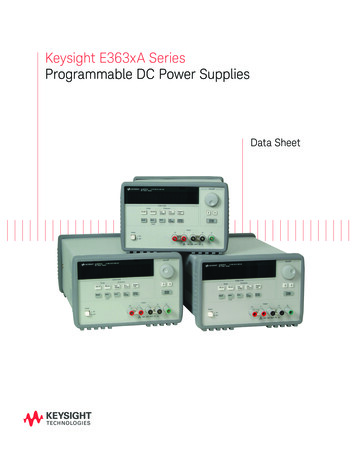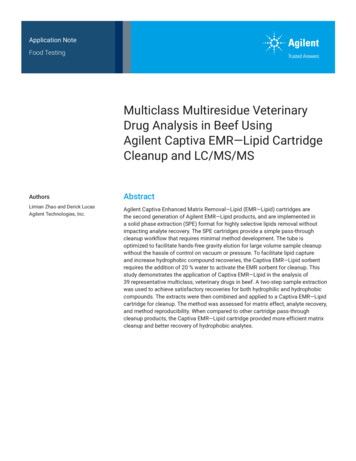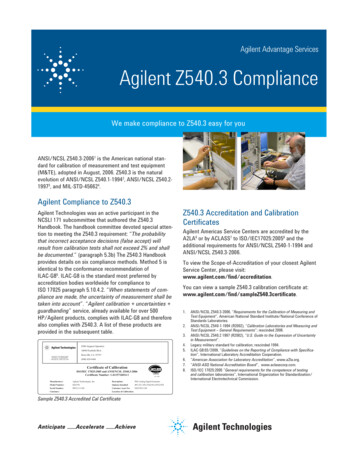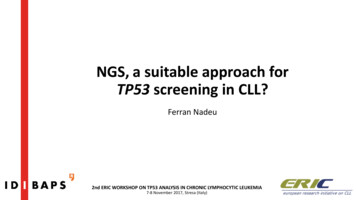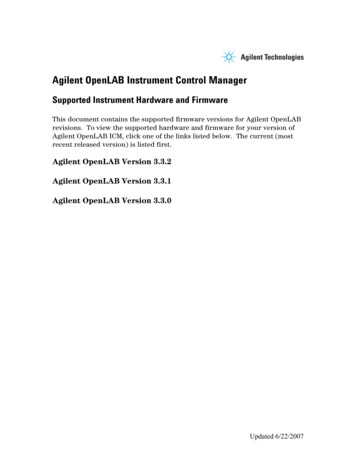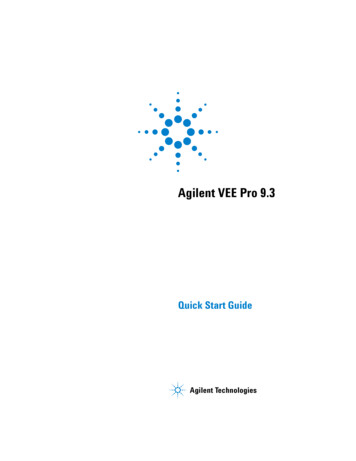
Transcription
Agilent VEE Pro 9.3Quick Start GuideAgilent Technologies
Notices Agilent Technologies, Inc. 2005 - 2011WarrantyNo part of this manual may be reproduced inany form or by any means (including electronic storage and retrieval or translationinto a foreign language) without prior agreement and written consent from AgilentTechnologies, Inc. as governed by UnitedStates and international copyright laws.The material contained in this document is provided “as is,” and is subject to changed, without notice, infuture editions. Further, to the maximum extent permitted by the applicable law, Agilent disclaims allwarranties, either express or implied,with regard to this manual and anyinformation contained herein, including but not limited to the implied warranties of merchantability and fitnessfor a particular purpose. Agilent shallnot be liable for errors or for incidental or consequential damages in connection with the furnishing, use, orperformance of this document or ofany information contained herein.Should Agilent and the user have aseparate written agreement withwarranty terms covering the materialin this document that conflict withthese terms, the warranty terms in theseparate agreement shall control.Manual Part NumberW4000-90045EditionFirst Edition, July 28, 2011Printed in MalaysiaAgilent Technologies, Inc.5301 Stevens Creek Blvd.Santa Clara, CA 95051 USATrademark AcknowledgementsPentium is a U.S. registered trademark ofIntel Corporation.Microsoft, Visual Studio, Windows, and MSWindows are trademarks of Microsoft Corporation in the United States and or othercountries.Technology LicensesThe hardware and or software described inthis document are furnished under a licenseand may be used or copied only in accordance with the terms of such license.Restricted Rights LegendU.S. Government Restricted Rights. Software and technical data rights granted tothe federal government include only thoserights customarily provided to end user customers. Agilent provides this customarycommercial license in Software and technical data pursuant to FAR 12.211 (TechnicalData) and 12.212 (Computer Software) and,for the Department of Defense, DFARS252.227-7015 (Technical Data - CommercialItems) and DFARS 227.7202-3 (Rights inCommercial Computer Software or Computer Software Documentation).Safety NoticesCAUTIONA CAUTION notice denotes a hazard. It calls attention to an operating procedure, practice, or the likethat, if not correctly performed oradhered to, could result in damageto the product or loss of importantdata. Do not proceed beyond aCAUTION notice until the indicatedconditions are fully understood andmet.WA R N I N GA WARNING notice denotes ahazard. It calls attention to anoperating procedure, practice, orthe like that, if not correctly performed or adhered to, could resultin personal injury or death. Do notproceed beyond a WARNINGnotice until the indicated conditions are fully understood andmet.Agilent VEE Pro 9.3 Quick Start Guide
ContentsIntroduction 2Installing Agilent IO Libraries 2Installing Agilent VEE Pro 4Launching Agilent VEE Pro 8Instrument Communication Tutorial 9Virtual Source Tutorial 13Agilent VEE 9.3 New Features 18Agilent Connectivity Products 19Agilent Support, Services, and Assistance 20Appendix 21Agilent VEE Pro 9.3 Quick Start Guide1
IntroductionWelcome to the Agilent VEE family! Agilent Visual EngineeringEnvironment (VEE) is a powerful visual language environment thatdramatically reduces your development time. To get you startedquickly on Agilent VEE, we have prepared this guide to show you howto install and use your new software. This guide also contains twotutorials that show you how to communicate with an instrument viathe USB interface, and how to generate and display a waveform froma virtual source.Installing Agilent IO LibrariesThe Agilent IO Libraries Suite software is included when youpurchase Agilent VEE. This software enables you to communicatewith instruments via serial, USB, GPIB, or LAN interfaces.You are required to install the Agilent IO Libraries Suite 16.1 beforeinstalling Agilent VEE if you need to communicate with instrumentsusing Agilent VEE. However, you can choose not to install the AgilentIO Libraries Suite if you do not use instruments.Follow these simple installation steps:1 Insert Agilent IO Libraries Suite CD into the CD- ROM drive.2 The InstallShield Wizard will guide you through the installationprocess. Click Next to accept the default settings and complete theinstallation.2Agilent VEE Pro 9.3 Quick Start Guide
3 The Agilent Connection Expert Welcome Screen window willappear. This application configures the instruments that areconnected to your PC. You may close this window beforeproceeding to the next step.Agilent VEE Pro 9.3 Quick Start Guide3
Installing Agilent VEE Pro1 Insert the Agilent VEE Installation CD- ROM and click Install AgilentVEE Pro 9.3. The InstallShield Wizard will guide you through theinstallation process.2 The InstallShield Wizard will check if Agilent IO Libraries Suite16.1 is installed. If it is not, the following message box will appear.Please note that Agilent IO Libraries Suite 16.1 is a prerequisite ifyou communicate with instruments using Agilent VEE. So, pleaseinstall Agilent IO Libraries Suite 16.1 or higher after finishing thisinstallation.3 Click OK, the InstallShield Wizard will check if Microsoft .NETFramework 3.5 SP1 is installed.4 If Microsoft .NET Framework 3.5 SP1 is not installed, followingQuestion dialog box will appear to ask you to install it. Click Yes toinstall the Microsoft .NET Framework 3.5 SP1 immediately. Afterthe installation, the Agilent VEE installation will continueautomatically. Clicking No will abort the Agilent VEE installation.4Agilent VEE Pro 9.3 Quick Start Guide
If Microsoft .NET Framework 3.5 SP1 is installed, the InstallShieldWizard will guide you to the next step directly to install yourAgilent VEE selection in Step 1.5 Click Next, when the following dialog box appears.6 Accept the license agreement when the License Agreement dialogbox appears, then click Next.Agilent VEE Pro 9.3 Quick Start Guide5
7 Type your name, company name, and product key when theCustomer Information dialog box appears, then click Next. Theproduct key is contained in the Agilent VEE Pro Product KeyCertificate.8 Click Next to accept the default settings when the following dialogbox appears.6Agilent VEE Pro 9.3 Quick Start Guide
9 Select Typical Setup when the Setup Type dialog box appears, thenclick Next to complete the installation.Agilent VEE Pro 9.3 Quick Start Guide7
Launching Agilent VEE ProGo to All Programs Agilent VEE Pro 9.3 VEE Pro 9.3 to launch Agilent VEEPro.Menu pertiesWindowOutputWindowStatus BarYou can access the demos, MATLAB examples as well as sampleprograms via the Agilent VEE Pro welcome window. You may closethe window after exploring it.You can also open sample programs from the menu bar. To open asample program, go to File Open Example .or Help Open Example.8Agilent VEE Pro 9.3 Quick Start Guide
Instrument Communication TutorialIn this tutorial, we will connect to an instrument via the USBinterface. Ensure that the Agilent IO Libraries Suite 16.1 is installedbefore proceeding.If you do not have a USB instrument, the tutorial for a GPIBinstrument is similar from Step 3 onwards.1 Connect to an instrument via any USB port on your PC. Then, turnon the instrument. The Found New Hardware Wizard dialog boxwill appear. Just step through the wizard by clicking Next.2 Launch Agilent VEE Pro, if you have not. Click the InstrumentManager buttonon the toolbar.3 The Instrument Manager tool window will appear. Click the FindInstruments buttonto automatically detect all instrumentsconnected to your PC.4 Click Yes if the Identify Instrument pop- up dialog box appears.This automatically identifies the instrument on the USB interface.In this example, the Agilent 34410A Digital Multimeter is present.Agilent VEE Pro 9.3 Quick Start Guide9
5 Right click newInstrument in the Instrument List panel. Then,choose Create Direct I/O Object to place a Direct I/O object for theselected newinstrument on the workspace. This object allows you tosend/receive commands to/from your instrument.6 Double- click the Direct I/O object blue transaction bar to add atransaction to the Direct I/O object.7 Type "*IDN?" (include the quotation marks) in the I/OTransaction dialog box as shown below. A list of available SCPIcommands may appear while you are typing. You can choose onecommand as desired instead of typing the whole command. ClickOK to proceed.*IDN? is one of standard commands for programmable instruments(SCPI) command that queries the instrument for its identificationstring.10Agilent VEE Pro 9.3 Quick Start Guide
8 After sending the "*IDN?" query to the instrument, you need toread back its response. Double- click the text box of thenewInstrument object to add a new transaction. This time, selectthe transaction to READ a STRING FORMAT text to an output terminalnamed x. The output terminal x will be automatically created whenyou click OK.9 Select Display AlphaNumeric and place an AlphaNumeric object onthe workspace to the right of the Direct I/O object.10 You will now connect the Direct I/O object to the AlphaNumericobject. Place the mouse cursor beside the Direct I/O outputterminal and a square icon will appear. Left- click and drag a lineto the input terminal of the AlphaNumeric object. Left- click againto complete the connection.Agilent VEE Pro 9.3 Quick Start Guide11
11 Run the program by clicking the Run buttonon the toolbar.12 The AlphaNumeric object will display the identification stringoutput by the instrument as shown below.13 To save your VEE code, select File Save As and name the file asTutorial 1.vee.12Agilent VEE Pro 9.3 Quick Start Guide
Virtual Source TutorialIn this tutorial, you will generate and display a waveform from avirtual source. No instrument is needed.1 If you have an existing program in your Agilent VEE Proworkspace, select File New. Then, select Device Virtual Source Function Generator and place a function generator object on theworkspace.2 By default, the function generator will generate a virtual cosinewaveform at a frequency of 200 Hz, and an amplitude of 1.Agilent VEE Pro 9.3 Quick Start Guide13
3 Select Display XY Trace and place an XY Trace object to the right ofthe function generator.4 Connect the function generator output terminal to the inputterminal of the XY trace. Place the mouse cursor beside thefunction generator output terminal and a square icon will appear.Left- click and drag a line to the input terminal of the XY Traceobject. Left- click again to complete the connection.5 Click the Run buttonon the toolbar and you can see thecosine waveform displayed on the XY Trace object.14Agilent VEE Pro 9.3 Quick Start Guide
6 Select Display Spectrum (Freq) Magnitude Spectrum and place aMagnitude Spectrum object on the workspace below the XY Traceobject.7 Connect a second line from the output of the function generator tothe input of the Magnitude Spectrum object using the sameleft- click and drag method as described in Step 4.8 Click the Run buttonand observe the magnitude spectrumdisplay. As the waveform is a 200 Hz cosine, the magnitudespectrum displayed will be a vertical line at the frequency of200 Hz.Agilent VEE Pro 9.3 Quick Start Guide15
9 Change the waveform function on the virtual function generator toa square waveform.16Agilent VEE Pro 9.3 Quick Start Guide
10 Click the Run buttonand observe the difference. Agilent VEEgives you the flexibility to analyze your signal source in multiplegraph displays simultaneously.11 To save your VEE code, select File Save As and name the file asTutorial 2.vee.Agilent VEE Pro 9.3 Quick Start Guide17
Agilent VEE 9.3 New FeaturesvToolsThere are two available vTools, General vTools and DAQ vTools.General vTools contains enhanced graph object with panning, scrollzoom, graphic saving features, and printing capabilities to improve thegraph object reporting feature. General vTools also supports objectsand components such as Averaging and Marker Lookup. DAQ vToolsoffers better integration and supporting files generated from AgilentMeasurement Manager for DAQ modules. The DAQ vTools is onlyavailable for Agilent U2300 and U2500 Series USB modular dataacquisition.New Sample ProgramsThere are new sample programs for Agilent 33500 series, 34411ADMM, and DSO/MSO scopes. These new sample programs willdemonstrate on simple programming for new Agilent instruments withVEE. For more information on the new sample programs, refer to theVEE 9.3 Help File.NOTE18Agilent also provides Agilent VEE Student and Agilent Education versionsfor academic users.Agilent VEE Pro 9.3 Quick Start Guide
Agilent Connectivity ProductsE5810A LAN/GPIBGateway82350B PCI GPIBInterface82357B USB/GPIBInterface10833XGPIB Cable82351A PCIe GPIBInterfaceAgilent provides a complete range of high performance and highlyreliable products to connect from your PC to your instruments. Theseinclude LAN/GPIB gateway, GPIB cable PCI GPIB, PCIe GPIB, andUSB/GPIB interfaces. For more information on Agilent connectivityproducts, visit www.agilent.com/find/gpib.Agilent VEE Pro 9.3 Quick Start Guide19
Agilent Support, Services, and AssistanceWith Agilent VEE Pro, you have access to the Agilent worldwideresources for start- up assistance, training classes, and updateservices. As part of the purchase of any Agilent VEE product you areentitled to receive technical support free of charge. There is no needto register.Additional consulting services are available from Agilent. There arecurrently over 30 companies available in North America, Europe,Middle East and Asia to help you develop your Agilent VEE solution.Sign up for the Agilent VEE forum athttp://www.agilent.com/find/veeforum, and get help on using AgilentVEE from experts around the world.Sign up for Agilent VEE e- learning courses (LearnVEE) athttp://www.agilent.com/find/learnvee.For an interactive help, you may also view Agilent VEE multimediademos at http://www.agilent.com/find/veedemos.20Agilent VEE Pro 9.3 Quick Start Guide
AppendixAgilent VEE Pro Help is now available in other languages. To useonline help file in other languages, please1 Download localized online help from www.agilent.com/find/vee.2 Save downloaded files into the installation directory of AgilentVEE. Generally, it is C:\Program Files\Agilent\VEE Pro 9.3. Pleasedo not change the name of the downloaded online help files.3 Open Agilent VEE software.4 Open the Default Preferences (File Default Preferences). Choosethe help file language as you need under the Help tab.5 Click OK to close the Default Preferences dialog box.Agilent VEE Pro 9.3 Quick Start Guide21
22Agilent VEE Pro 9.3 Quick Start Guide
www.agilent.comContact usTo obtain service, warranty or technical supportassistance, contact us at thefollowing phone numbers:United States:(tel) 800 829 4444(fax) 800 829 4433Canada:(tel) 877 894 4414(fax) 800 746 4866China:(tel) 800 810 0189(fax) 800 820 2816Europe:(tel) 31 20 547 2111Japan:(tel) (81) 426 56 7832 (fax) (81) 426 56 7840Korea:(tel) (080) 769 0800(fax) (080) 769 0900Latin America:(tel) (305) 269 7500Taiwan:(tel) 0800 047 866(fax) 0800 286 331Other Asia Pacific Countries:(tel) (65) 6375 8100(fax) (65) 6755 0042Or visit Agilent worldwide web at:www.agilent.com/find/assistProduct specifications and descriptions in thisdocument are subject to change without notice.Always refer to Agilent Web site for the latestrevision. Agilent Technologies, Inc. 2005 - 2011Printed in MalaysiaFirst Edition, July 28, 2011W4000-90045Agilent Technologies
Agilent VEE Pro 9.3 Quick Start Guide 9 Instrument Communication Tutorial In this tutorial, we will connect to an instrument via the USB interface. Ensure that the Agilent IO Libraries Suite 16.1 is installed before proceeding. If you do not have a USB instrument, the tutorial for a GPIB instrument is similar from Step 3 onwards.
